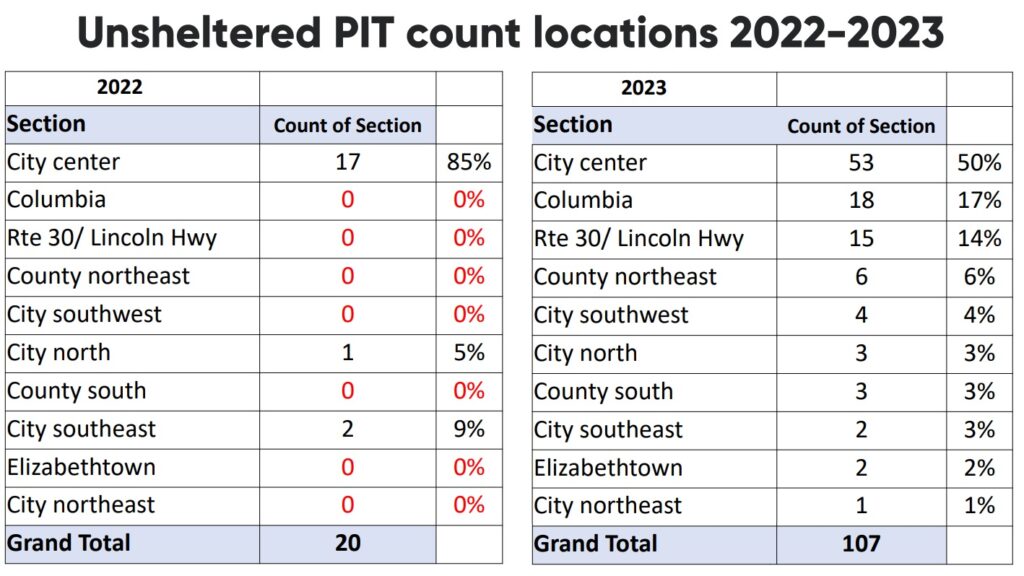Lancaster County’s annual one-night census of its homeless population jumped 11% from 2022 to 2023, figures from the county’s Homelessness Coalition show.
That increase, from 472 individuals last year to 526, was driven by increases in two of the count’s three categories: a 40% increase in the number of individuals in emergency shelters, and a nearly fivefold increase in the count of people sleeping out of doors. The former number jumped from about 190 to about 270; the latter jumped from 23 to 107.
While some of that latter increase may reflect an increase in the unsheltered population, much of it is likely due to changes in methodology, coalition officials said.

Before this year’s count, organizers took a “deep dive” into best practices and revamped their approach, said Deb Jones, director of human services at the Lancaster County Redevelopment Authority, where the coalition’s office is based.
Known as the “Point in Time count,” or PIT count, the one-night count is required of communities across the country as a condition of receiving U.S. Housing & Urban Development funding for homelessness services. It is normally conducted in late January — in Lancaster County’s case, this year’s count took place on Tuesday, Jan. 24. It was reported to HUD in the spring.
A total of 43 volunteers, organized into 18 teams, participated in the count of unsheltered individuals. The number of locations surveyed was expanded.
Because it’s the outreach workers who know conditions in the field first-hand, the project’s organizers empowered them to take the lead on where to go and at what time. Maps were prepared for volunteers to follow.

In previous years, people were counted only if a PIT count team member interviewed them. This year, individuals observed sleeping outside were included as well.
One big change: Binns Park was surveyed in the evening, when more people typically congregate there, rather than the morning.
The coalition partnered with Lancaster General Hosptial to interview individuals released from the emergency department. Those who said they were sleeping outside were added to the total.
The coalition hopes to continue that going forward, and potentially add other hospitals, homeless housing programs coordinator Marjorie Shaffer said.
Lastly, outreach workers interviewed people on two follow-up days in seven-day period after the count, as allowed under HUD guidelines. Those who said they had been outside on Jan. 24 were added in.
Besides unsheltered individuals, the PIT count includes people in emergency shelters and transitional housing. Adding in those populations, about 270 and 149, respectively, yields 526 total persons.
That’s the highest number in Lancaster County since the 562 recorded in 2012. The lowest count in recent history, 321, came in 2017; in the six years since, it has risen by 64%.

The increase in the emergency shelter census was not a surprise. The coalition knows there is an urgent need to expand capacity and is scouting sites for an additional 40 shelter beds, to be set up and available by Dec 1.
The county’s PIT numbers for transitional housing ebbed in 2023 after expanding significantly in the previous couple of years. That was when the county was housing people in hotels using pandemic rental assistance; the numbers reflect the expansion and wind-down of that effort, said Christopher Thomas, the coalition’s data compliance analyst.
An area’s PIT count is one of the variables HUD uses to calculate federal funding for homelessness services. For localities, it is a snapshot that, combined with other data, helps them develop their housing stability programs and strategies and illustrates the impact of the housing crisis.
On the other hand, it has sharp limitations. The unsheltered population can vary dramatically from one night to the next, depending on the weather and other factors. Agencies’ data collection capabilities vary as well.
While homelessness has many causes, there is no doubt rising rents and housing scarcity are among the most important. In 2020, Lancaster County’s vacancy rate was among the tightest in the country, at 4.6%. About half of Lancaster County renters are cost-burdened, paying 30% or more of their income in rent.
The coalition intends to start its planning for the 2024 PIT count even farther ahead of time, Jones said. It’s talking with organizations in other regions about their practices, to see what could be adapted here, Shaffer said.






